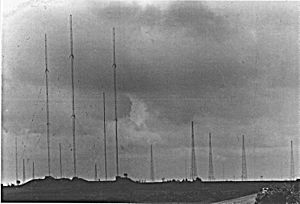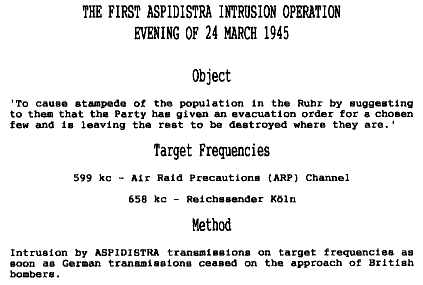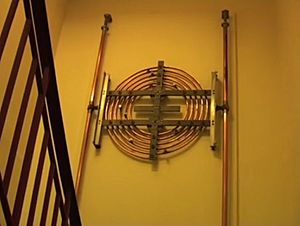Aspidistra (transmitter) facts for kids
Aspidistra was a very powerful British radio transmitter used during World War II. Its main job was to trick Nazi Germany and spread secret messages. At one point, it was the strongest broadcast transmitter in the whole world!
The name Aspidistra came from a funny song called "The Biggest Aspidistra in the World". An aspidistra is a common houseplant, and the song was about something huge and impressive, just like this transmitter.
It was set up in 1942 near Crowborough in southeast England. Other smaller transmitters were also there, known as ASPI 2, ASPI 3, and so on. But when people said Aspidistra, they usually meant the original, super-powerful one (ASPI 1).
During the war, the British government's Political Warfare Executive (PWE) ran the Crowborough station. After the war, the Diplomatic Wireless Service (DWS) took over. They used it for BBC External Service broadcasts to Europe. The station finally closed down in 1982.
Contents
What was Aspidistra like?
Aspidistra sent out signals on medium wave (like regular AM radio) with an amazing 600 kW of power. The transmitter was originally built by an American company called RCA for a radio station in the United States. However, a new rule in the US limited how powerful radio stations could be. So, RCA was happy to sell it overseas. The British Secret Intelligence Service bought it for £165,000.
One special thing about Aspidistra was that it could change its frequency very quickly. This was super useful for its secret wartime missions. Most medium wave transmitters usually stayed on one frequency all the time.
The antenna had three tall masts, each about 110 meters (360 feet) high. These masts helped send the signal mainly towards the east, into Europe. The main building for the transmitter was underground. It was built in a cool Art Deco style from the 1940s. Huge diesel engines provided the power, as the local electricity wasn't strong enough.
The station was located on a high part of Ashdown Forest, about 195 meters (640 feet) above sea level.
Over the years, other medium wave and short wave transmitters were added to the site. Some of these could even combine their power to reach 500 kW on one frequency. Two 100 kW short wave transmitters from General Electric (USA) also worked at the Crowborough site from 1943 until the 1980s.
How powerful was Aspidistra?
For some time, Aspidistra was the most powerful broadcast transmitter in the world. However, during most of the war, another BBC transmitter near Hull was even stronger. That one was also used to broadcast to Europe.
Aspidistra was also less powerful than Germany's Goliath transmitter. But Goliath was used for talking to U-boats, not for regular radio broadcasts.
Aspidistra's Wartime Missions
Aspidistra started working on November 8, 1942, and stayed active for the rest of the war.
Tricking German Pilots
Starting in 1943, Aspidistra helped mess up German night fighter operations. These fighters were trying to stop Allied bombers flying over Germany.
German radar stations would broadcast where the bombers were going. British operators, who spoke German perfectly, pretended to be these German controllers. They sent fake instructions to the German night fighters. They told them to land or go to the wrong areas. This trickery was called "Dartboard." When the Germans changed their methods to avoid being tricked, the British copied them. They even brought in WAAFs when the Germans started using female operators.
Secret Propaganda
Aspidistra was also used for black propaganda. This means spreading messages that seem to come from one source, but actually come from a secret, different source. These activities were managed by the Political Warfare Executive.
For example, Aspidistra broadcasted shows from Atlantiksender and Soldatensender Calais. These stations pretended to be official German military radio stations located in France.
Sneaky "Intrusion" Operations
During Allied air raids, German radio stations in targeted cities would often turn off. This was to stop enemy planes from using them to find their way. However, these stations were often part of a network, broadcasting the same shows as other stations that stayed on.
When a German station turned off, Aspidistra would start broadcasting on that exact frequency. At first, it would just play what the German network was already broadcasting. This made German listeners think their local station was still on. Then, Aspidistra operators would secretly add discouraging false news and pro-Allied messages into the broadcast. This was very effective because it sounded like it was coming from official German sources.
These "intrusion operations" were an early example of a "man in the middle attack". This is when someone secretly gets between two communicating parties.
The first intrusion happened on March 25, 1945. On March 30, 1945, Aspidistra tricked stations in Berlin and Hamburg. It warned that the Allies were trying to cause confusion with fake phone messages. On April 8, 1945, Aspidistra warned Hamburg and Leipzig about fake money. On April 9, 1945, it encouraged people to move to "bomb-free zones" in Germany. All these messages were completely false.
German radio stations tried to fight back. They announced, "The enemy is broadcasting fake instructions on our frequencies. Do not be misled by them." But Aspidistra also started broadcasting similar warnings, leaving listeners totally confused!
After the War
Even during the war, Aspidistra was sometimes used for regular BBC European Service broadcasts.
After 1945, the BBC continued to use Aspidistra. It broadcasted on several different frequencies over the years. For example:
- 1122 kHz (1945–1950)
- 1340 kHz (1950–1962)
- 647 kHz (1950–1965), but only during the day
- 1295 kHz (1962–1978)
- 809 kHz (1967–1978), just for a French lunch program
- 1088 kHz (1972–1978)
In 1978, there was a big reorganization of radio frequencies across Europe. After that, Aspidistra only used 648 kHz.
Even though the BBC used it almost all the time after the war, the Crowborough station officially belonged to the Foreign Office. Its staff were part of the Diplomatic Wireless Service, not the BBC.
End of an Era
Aspidistra sent its last signal on September 28, 1982. Harold Robin, the engineer who bought the transmitter 40 years earlier, had the honor of turning it off for the last time.
The station was taken apart in 1984. Two years later, the underground bunker that held Aspidistra was changed. It became one of 17 sites in England and Wales that would be used by the government if there was a nuclear attack.
From 1988, Sussex Police used parts of the site. In 1996, they bought the whole area to use as a training facility.
In 2007, one of the buildings (Building No. 3) was given a special "Grade II listed" status. This means it's an important historic building. It was noted for being "remarkably intact" and showing how a 1940s transmitter hall worked.
The Aspidistra transmitter itself was offered to London's Science Museum, but they didn't take it. So, it was scrapped. However, some parts, like large tuning coils, were saved by engineers. You can now see them at the Orfordness station. A sign there explains its history:
One of three RF output coupling coils from the Aspidistra 1 transmitter at Crowborough in Sussex.
ASP1 was a 600 kW medium wave transmitter which was installed and commissioned with great urgency by Harold Robin during the spring and summer of 1942 and which commenced broadcasting on 8 November 1942. The transmitter was in continuous service for the next 40 years, carrying "black" propaganda to the enemy in wartime and BBC External Services to Europe in peacetime. It ceased regular transmissions on 28 September 1982 and its services were transferred to Orfordness. It was dismantled in May 1984.
This coil is preserved as a memento of a transmitter which played a large part in the wartime activities of the Political Warfare Executive. In peacetime it became part of the expanding broadcast transmission facilities provided for the External Services of the BBC by the Diplomatic Wireless Service – now the Communications Engineering Department of the Foreign and Commonwealth Office.
October 1984
See Also
- Osterloog transmitting station, a German propaganda transmitter in Lower Saxony





